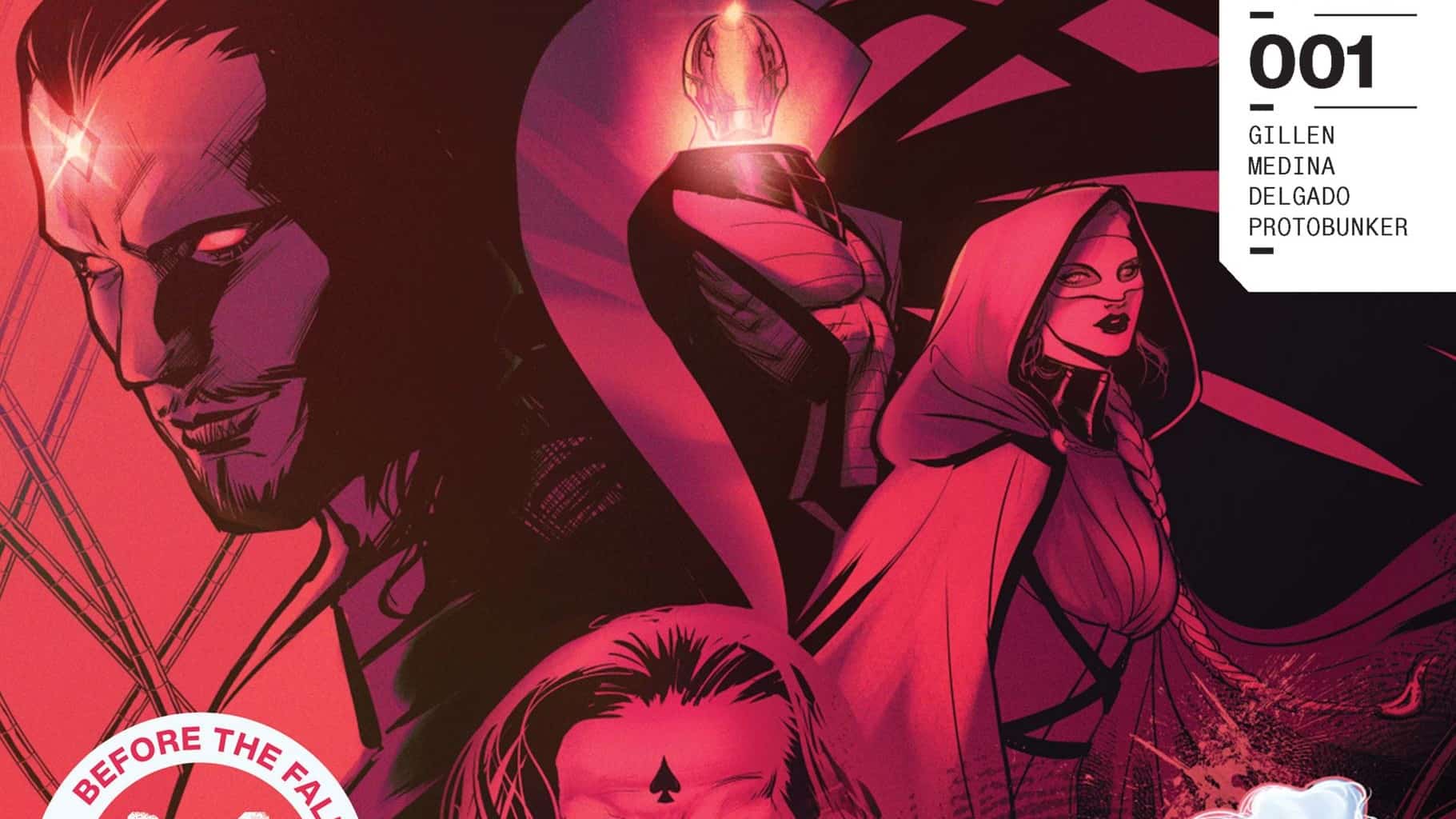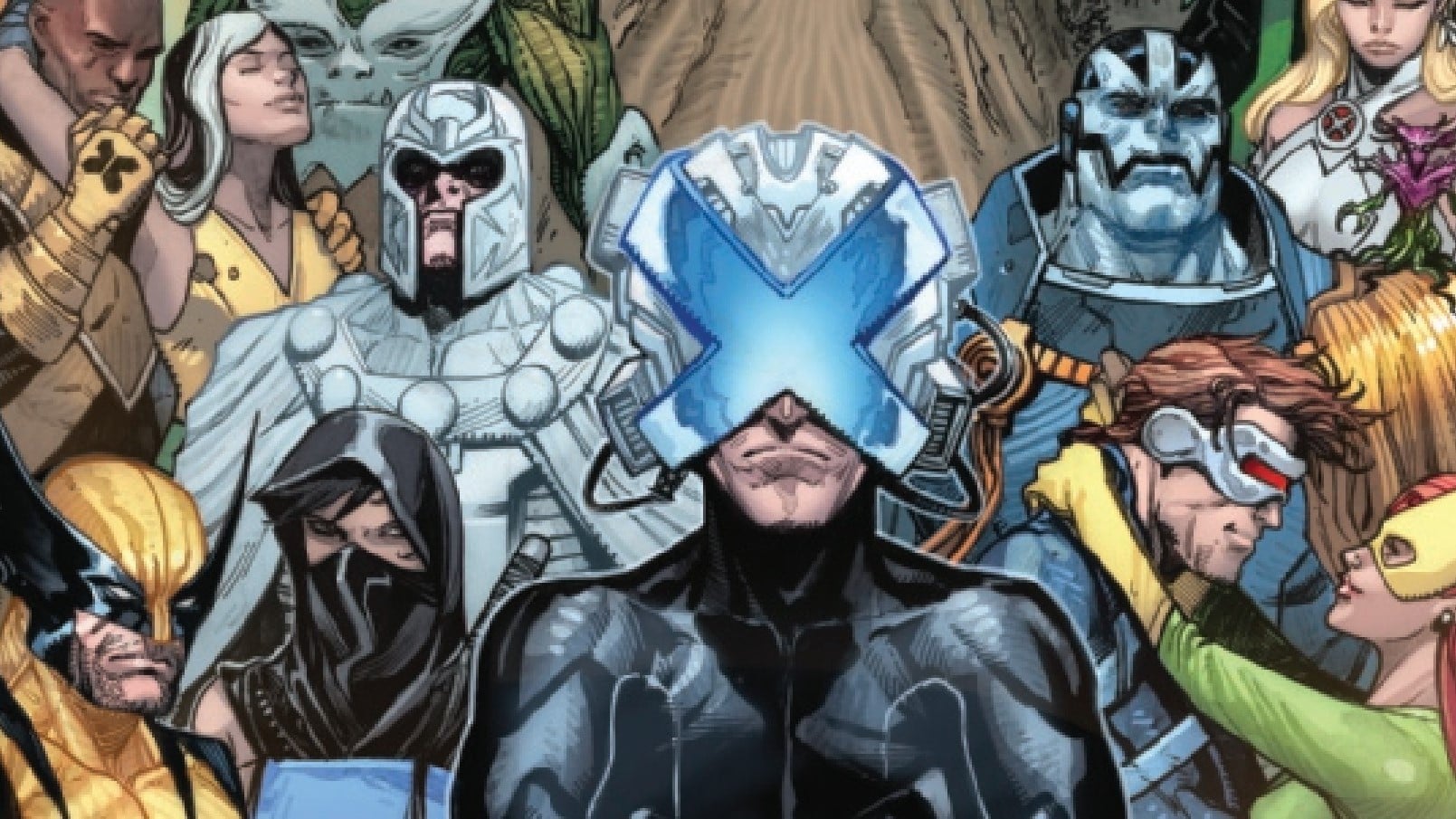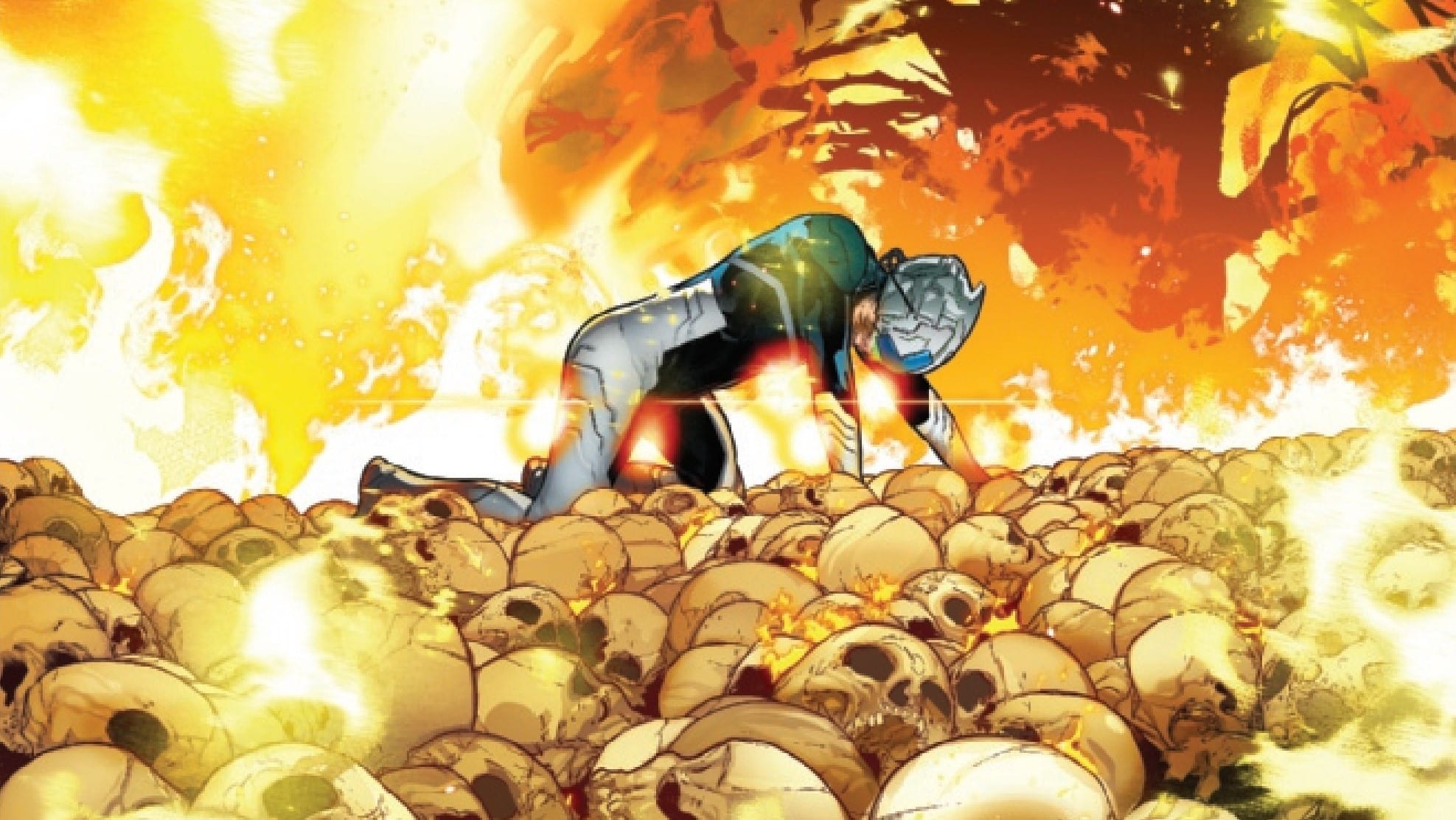Doctor Stasis and Mother Righteous reunite after more than a century apart. X-Men: Before the Fall: The Sinister Four #1 is written by Kieron Gillen, drawn by Paco Medina, colored by Edgar Delgado and Protobunker’s Fer Sifuentes-Sujo, and lettered by Clayton Cowles.
Mark Turetsky: Rasmus! It’s good to see you again after all these years (months)! But is it really us? Are we the same people who wrote about Sins of Sinister, fundamentally?
Rasmus Lykke: I’d like to think we’re better!
Constantly evolving, getting better and more confident in ourselves, learning from our mistakes and not missing an obvious flirtatious moment, like we did in our last review! I mean, of course Kate Pryde is going to be crushing hard on Rasputin IV! She’s double the Rasputin, and Kate obviously has a weakness for our favorite self-sabotaging Russian family!
Anyway, let’s dig into this special one-shot of two people talking, with no complex feelings barely hidden beneath the surface!
Young Victorians in Love

Mark: The issue opens, not on the two characters we follow in the rest of the issue but, important caveat, the people those two characters are based on. Or, to be a bit more precise, the rest of the issue focuses on one of these characters’ ideas of who they are, or who they could be. It’s like how William James wrote, “When two people meet there are really six people present. There is each person as they see themselves, each person as the other person sees them, and each person as they really are.” Here are two people as they really are, and in the rest of the issue, two people as Nathanial Essex sees them, with a century and a half of growth added on.
Rasmus: When Rebecca says on the first page that she “loves a good story” and Essex replies “Then I will give you one,” he is being very literal, because when he later clones her, he definitely defines the shape of her story going forward.
Mark: And this sets the tone. This is very much a story about stories, which has a long tradition in the English canon (as well as other canons, no doubt).
Rasmus: And it is one of Gillen’s favorite subjects, though he doesn’t view stories in the same way that Grant Morrison, Neil Gaiman or Alan Moore do. They tend to focus on the positive power of stories, the way that stories can change us and help us grow. Gillen instead tends to focus on the danger of stories. That as stories are the closest thing we get to telepathy, stories can also be dangerous. And that the most dangerous stories of all are the ones we tell ourselves. Even — or especially — if you’re literally creating four different versions of yourself to explore different stories of yourself, as Nathanial Essex does here.
Mark: It’s especially reminiscent of Gillen and Dan Mora’s Once and Future, which literally has different versions of Arthurian legend battling it out for supremacy. Add in Essex’s likely skewed understanding of Darwinian theory, and you’ve got not just four stories out to achieve a goal, but four stories vying to be the fittest story, the one that will reign supreme.
Rasmus: And the interesting thing is: We know that one of them will succeed! In Sins of Sinister, Mister Sinister discovered that an Essex had reached Dominion status, it just wasn’t him. Which means that at one point, one of the others will. Nathaniel Essex will succeed in his mission. But which one — and at what cost — is still up in the air.
Mark: And lest we bury the lede of this opening scene, it’s the moment at which they become engaged to be married. With this scene set in 1852, we know she’ll give birth to Adam the following year. Adam lives to the age of 4, putting his death circa 1857. Two years after that, in 1859, Rebecca miscarries and dies. We’re still several decades from Essex’s death and the creation of the clones, which happens in 1895, according to Immortal X-Men #8.
Rasmus: Stasis does a lot to present himself — and in turn Essex — as turning to Apocalypse and later his cloning experiments as a result of Nathaniel and Rebecca’s dead children. But with almost 40 years between the events, it’s hard to accept. He’s either lying to her, himself or Essex has simply programmed him that way. Either way, it’s classic Sinister. Saying one thing, but another being true. Or at least more true.
Mark: Or Kieron Gillen needed to square it all with the complex and contradictory continuity of the X-Men.
Rasmus: It’s also classic date behavior, trying to make yourself look better, either by lying or by not getting into X-Men continuity.
Mark: I almost always avoid that subject while on a date.
A Very Important Date
Mark: Speaking of, like the villain (or Victorian vat-raised clone) that he is, Stasis uses a business meeting as the pretext for a date. This is some business ethics 101 stuff here: Don’t try to turn your business meeting into a romantic one. But somehow I doubt Orchis’ HR guidebook gives much of a crap about such things.
Rasmus: Honestly, Stasis’ lack of ethics is almost worth it, just for the wonderful shot Paco Medina draws of him looking like a giddy, nervous schoolboy as he presents the idea.
And then the food is served: tiny steaks that have to be shot with a gamma-powered rifle to enlarge them. Is there a reason for this, beyond it looking cool? I doubt it. But it says so much about Stasis, how carelessly he uses science for his own needs and, most importantly, his feelings in the moment, how desperate he is to impress Mother Righteous.
Mark: It’s molecular (subatomic?) gastronomy gone mad. Had it been Sinister trying to impress, it would have been an amalgamation of the most delicious mutants. But of course, Sinister wouldn’t be interested in a date. This is all to show us how thoroughly Stasis is not Sinister. He’s not as selfish as Sinister. He doesn’t use wit to distance himself from his (nonexistent) emotions. In a word, he cares. He cares maybe too much. This scene can be read in many ways: Are they two former lovers? Are they ghosts, damned to wander the Earth with their unfinished business? Are they merely one man’s scientific glow-up and his idealized, vat-grown wife? Are they two Frankenstein’s monsters, incomplete people looking for meaning in each other? Is there really anything of Rebecca herself in Righteous?
Rasmus: Given how long it’s been between her death and when Essex cloned her, I’d venture no. But this is comics, so who knows? No matter what, finding it will be interesting.
Not far into the date, there’s the classic superhero trope of finding out new characters were actually present during pivotal Marvel moments, Stasis at the origin site of science-based characters Captain America, Spider-Man and Hulk, and then Righteous at magical moments, such as Apocalypse, the Maximoff twins and reading the Darkhold. It’s all well and good, but it’s also not as exciting as it was 10 years ago. Thankfully, Gillen knows this and doesn’t exactly treat it as a huge revelation, more as background for both characters. They’ve been here and they’ve been busy, each doing their own things. Which makes the promise of them getting up to mischief together more exciting. This is clearly also what’s on Stasis’ mind when he proposed the date. But Righteous knows things are more complicated than that.
Mark: And the question keeps popping up in this issue of who exactly is manipulating whom? Who’s on top here? Since we only get Stasis’ thoughts, we know that he thinks he can see through her games. But does he know about her power of thanks? Does he know about her other intrigues on Krakoa? She shows him her book of the history of the Sinister timeline (Hey, I wonder if the Sins of Sinister omnibus will be bound to look like that?). When she does, we get a data page, but we should be clear: The data page we see is not the book she’s showing him. It looks entirely different, and it narrates Righteous showing Stasis the Sinister book (“On a date overlooking London, she showed Doctor Stasis”).
Which leads to the question of who is writing this story? Who wrote that data page? We saw a similar thing in Immortal X-Men #12, with Chronicler writing the story of Piotr Rasputin, Colossus, but this looks different in style from Chronicler. And Chronicler seems to be able to write about one person at once, not to influence whole casts of characters. Could it be some kind of omega-level version of Chronicler’s abilities? Or is it merely a different ability: the ability to see things and write them down as if they were fictions, without being able to change them?
Rasmus: Is it Destiny’s Diaries?
Mark: As it’s labeled an “uncorrected manuscript,” I’d find it hilarious if someone submitted Destiny’s Diaries to a publisher.
Rasmus: Hey, those royalties add up over the years. Both Destiny and Mystique live long lives.
Chronicler hasn’t played a big part outside of X-Force and the brief glimpse in Immortal X-Men #12, whereas Destiny has been central for a long time. As have her new books. Is she behind the data pages? It would make sense that Hickman brought her back before he left. We don’t know yet, but hopefully we’ll find out at some point.
What we do know now — for certain — is that none of the Sinisters are the real Nathaniel Essex. Not Mr. Sinister, not Doctor Stasis, Orbis Stellaris or Mother Righteous. They’re all clones created by the real Essex, as he died from Apocalypse’s implants, fearful for what the future would bring and trying his best to prevent it. Four versions of what he thought could save mankind from the rise of artificial intelligence. And each programmed by him to execute a function.
Mark: Of course, Stasis believes, egotistically, that he’s the one the long-dead Essex hoped would win.
Rasmus: Just like all the others.
And as Stasis and Righteous, the remnants of Nathaniel and Rebecca, ponder the future, the revelations of her book make them turn to the past.
I Dreamt I Went to Milbury Again

Mark: They take a little trip to their progenitors’ home, Milbury House. They stand over the smashed grave of Essex and Rebecca’s son, Adam. Stasis restores the gravestone, adding Rebecca and the stillborn Morgan’s names to the grave (Essex buried them without a headstone). It’s a monument of loss for Stasis. Of the things Essex lost and of the people he didn’t value highly enough in his life. Stasis asserts that Sinister wouldn’t mourn like he does, but Righteous calls him on his bullshit, telling him that what he’s done, what he’s doing, isn’t mourning.
Rasmus: Just like what Essex does when he creates Righteous isn’t love. They’re all flawed creatures, following a flawed design. And they know it. “Could a creature with his head all cut up by Apocalypse make anything other than monstrosities?” asks Mother Righteous, just as much to us readers as to Stasis. And — as is Gillen’s wont — can they rise above the story their creator intended for them?
Mark: And here’s the thing: Throughout this issue, Righteous replaces the stories that Essex put in Stasis’ head about their history, but why should we trust Righteous’ versions of events any more than we should trust Essex’s? She calls back to Ada Lovelace’s “Poetical Science.” For those who don’t know, Lovelace was the daughter of Lord Byron and contributed enormously to computing and computer science. She’s considered to be the first computer programmer. Poetical science grew out of Romanticism, which was the prevailing artistic style in the early 19th century. Romanticism emphasized the individual, the subjective experience of the subject, rather than a cold, objective realization. With poetical science, Lovelace put forward that intuition, observation and imagery were important to understanding science. For instance, you could read dry facts about the Earth, but it doesn’t give you the same understanding as Sagan’s Pale Blue Dot, just as an example. This is not to say Lovelace wasn’t concerned with facts and figures: She very much was a scientific and mathematical genius. Righteous claims that Essex created her as a being of poetical science. Of course, in the Marvel Universe, where magic is literally real, as real as chemistry or astrophysics, that takes on a magical quality as well.
Rasmus: And all magicians know that the most important part of magic is misdirection.
After distracting Stasis with his past, Righteous is ready to get what she actually wants from him. His help is freeing Selene from Charon’s realm of death. She is playing him like a fiddle. Referring to herself as his missus, finally calling him Nathaniel, generally playing to his arrogance — the hamartia of all Essexes.
Mark: And Stasis’ super-science inventions, from his Sinister Six Shooter to his vibranium Pym grenade, mirror Sinister’s inventiveness, except instead of using mutant genes to do impossible things, it’s the stuff of Marvel’s science heroes and villains that gets used. A similar approach using different tools. Of course, this also answers the question of how Selene came back in last month’s Immortal X-Men.
Rasmus: The Essex couple, literally figuratively giving each other the moon.
Mark: And while the title of this one-shot promised us “The Sinister Four,” Sinister and Orbis Stellaris are more or less absent from this issue. Well, Sinister is definitely felt as a presence-in-absence. And as for Orbis Stellaris, he’s the big surprise.
Rasmus: Yeah, for all of Mother Righteous’ machinations throughout the issue, for all the ways we see her play Stasis and bend him to her will — all of which is even reflected in the final data page — Stasis was using her just as much. He has his own plans for her. He does it all for her. But that doesn’t mean he does things how she wants them. Instead he’s still the Victorian husband. He wants her to obey him first and foremost. And it seems he has partnered with the final Essex to do this, as Orbis Stellaris — the Spade Essex — shows up on the final page.
Mark: And the question is: Did Essex program that obedience into Mother Righteous? Could she overcome it? Would it even be obedience to Stasis in the first place? Why not one of the other Essex clones?
All this imagery of the four card suits has me thinking … are you at all familiar with contract bridge?
Rasmus: Not even a little bit!
Mark: Well, in contract bridge, the four suits are ranked. They go clubs, diamonds, hearts, spades, from lowest to highest. Clubs and diamonds are referred to as the minor suits, they’re lower in the auction and are worth fewer points in the scoring phase. Hearts and spades are the major suits, worth more. Now, let’s look at the Sinisters: Stasis and Sinister are represented by the minor suits. Their interests lay in the worldly, making the most of the rough stuff of earthly science. Mother Righteous and Orbis Stellaris are represented by the major suits. They aren’t so much interested in crude matter as they are in the magical and the cosmic. The spade, the highest suit, is represented by Orbis Stellaris, the clone trying to achieve a cosmic consciousness, even.
Anyway, if they can spend an entire 22-issue event centered on tarot imagery, why not base some villains on the values of regular playing cards?
Rasmus: Maybe in Fall of X!
Where everything comes falling down like … a house of cards. (I’m sorry!)
Mark: Oh. Oh, Rasmus. I love it.
X-Traneous Thoughts
- Very clever title to this one: “Lonely Hearts Club,” referring to the two “suits” of Sinister we see here.
- The Sinister Six-Shooter is such a delightful idea, I’m surprised no one has come up with it before.
- “Austen and that feminine stuff.” Tell me you haven’t read Austen without telling me you haven’t read Austen, Stasis.
- Looking at what was going on in London in 1852, the first public women’s toilet was opened within walking distance of where we see Essex and Rebecca on their promenade. Could it be?







